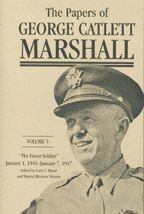
Reviews
Volume 5 of the Marshall Papers possesses the same laudable features as its predecessors: selections from a variety of sources; meticulous attention to detail; and numerous helpful aids, including a chronology and excellent illustrations.
Offers invaluable perspectives upon the whole history of the twentieth-century American army, as well as upon Marshall's own development in stature.
This perceptively selected, well-edited cross section of his papers... chronicles more than the development of one of America's greatest military administrators. The insight this work presents into the U.S. Army's doctrinal and institutional evolution between 1898 and 1939 earns it a place in all major libraries.
Indispensable for any scholar of modern military history, invaluable for a reflection of social attitudes in America in the first half of the 20th century, and pleasurable reading under any circumstances.
An important, even a necessary, event.
Superbly compiled by the editors... the collection is certain to become a major historical resource on the development of the American military and foreign policies.
Almost every document the editors include is fascinating in itself, largely because of the vigor of Marshall's mind and his eye for detail... An enthralling study America was equipped for battle.
Marshall's capacity to deal simultaneously with minutia and the largest issues of national security is clearly documented in his own letters and memoranda, leaving no doubt that he was a genius at preparing for war at a time when Congress and public opinion were ambivalent and the President uncertain and devious.
Nobody who is interested in the career of General Marshall, or in World War II generally, is likely to be unfamiliar with the previous volumes in this series. The superlatives earned by those books apply here as well: the editorial approach is clear, the annotation superb—complete without being pedantic... It is hard for people today to appreciate the unique stature Marshall achieved in his own time. If they wish to try, they could not do better than to begin with these papers.
Book Details
Preface
Guide to Editorial Policies
Illustrations
Chronology: January 1, 1945-January 29, 1947
Part I. Maintaining the Momentum: January 1-April 12, 1945
Part II. A Great Victory: April 12-July 10, 1945
Par
Preface
Guide to Editorial Policies
Illustrations
Chronology: January 1, 1945-January 29, 1947
Part I. Maintaining the Momentum: January 1-April 12, 1945
Part II. A Great Victory: April 12-July 10, 1945
Part III. The Future Peace: July 11-November 27, 1945
Part IV. Inobtrusive Manner: November 27, 1945-April 12, 1946
Part V. In the Middle: April 13-August 31, 1946
Part VI. Greatest Obstacle to Peace: September 1, 1946-January 7, 1947
Appendeix: Principal War Department Officials and Major Theater Commands, January 1945-December 1946
Maps and Charts
Glossary
Index




